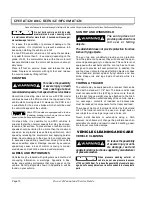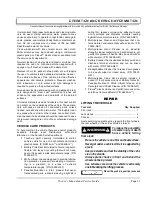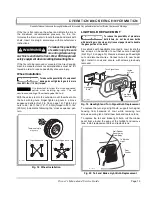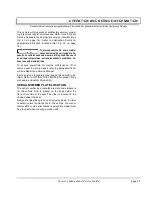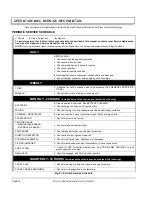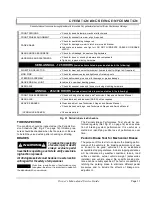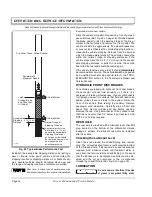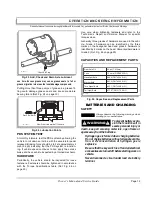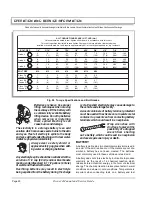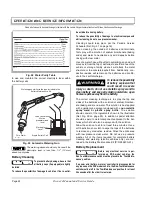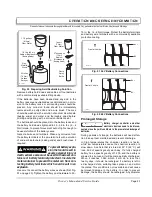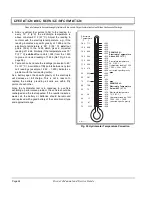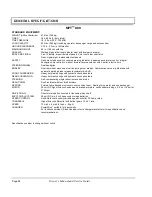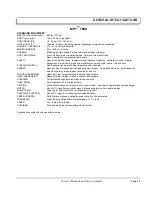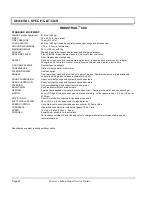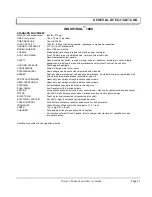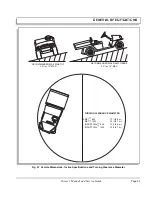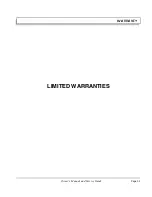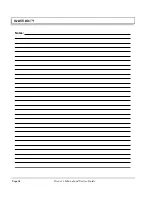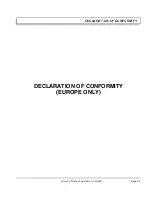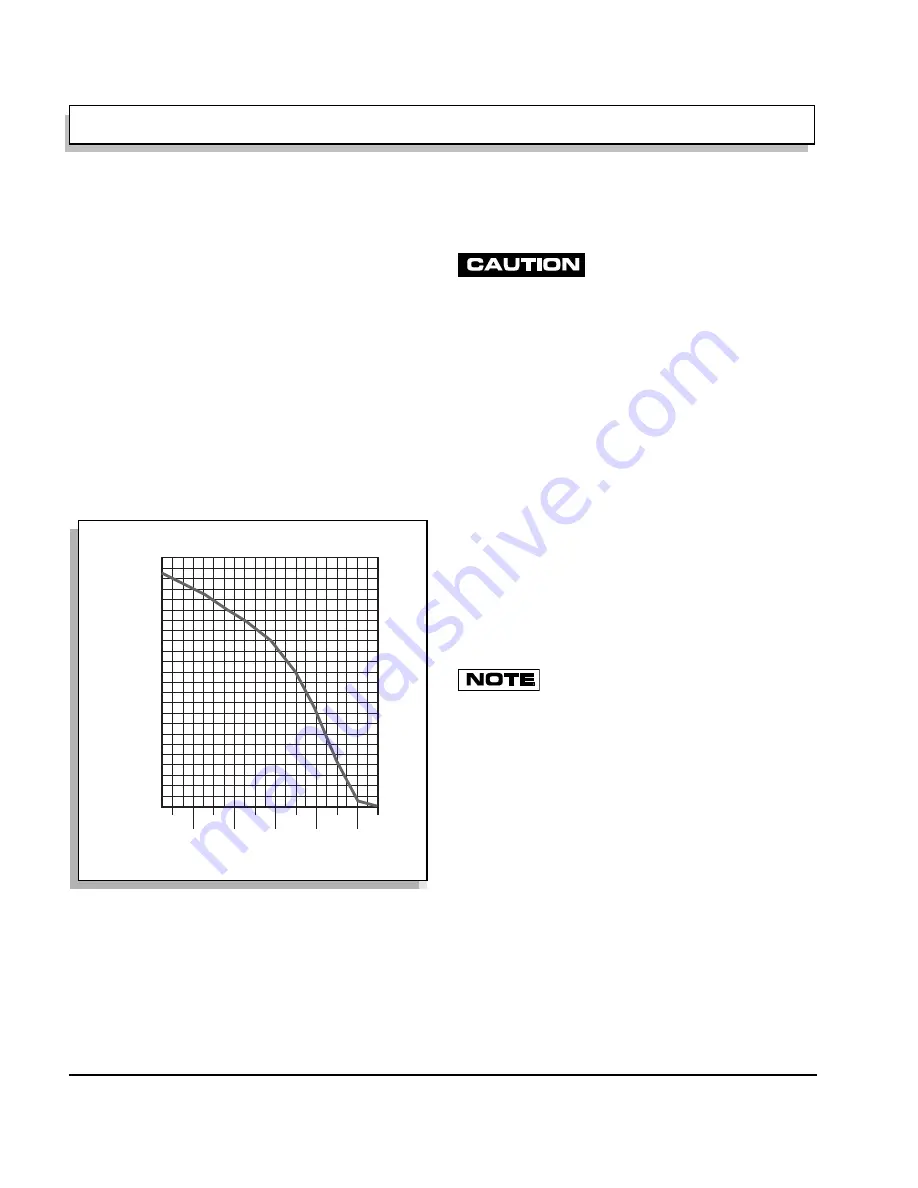
OPERATION AND SERVICE INFORMATION
Page 24
Owner’s Manual and Service Guide
Read all of manual to become thoroughly familiar with this vehicle. Pay particular attention to all Notes, Cautions and Warnings
can be used to determine the specific gravity and there-
fore the state of charge of a battery.
In winter conditions, the battery must be fully charged to
prevent the possibility of freezing (Ref. Fig. 33 on page
24). A fully charged battery will not freeze in tempera-
tures above -75° F (-60° C). Although the chemical reac-
tion is slowed in cold temperatures, the battery must be
stored fully charged, and disconnected from any circuit
that could discharge the battery. For PDS vehicles, the
controller should be disconnected from the batteries by
setting the Run-Tow/Maintenance switch, located under
the passenger seat, to the ‘TOW/MAINTENANCE’ posi-
tion. For portable chargers, disconnect the charging plug
from the vehicle receptacle. For on-board chargers, dis-
connect the charging harness from the batteries. The
batteries must be cleaned and all deposits neutralized
and removed from the battery case to prevent self dis-
charge. The batteries should be tested or recharged at
thirty day minimum intervals.
BATTERY CHARGING
The
battery charger is designed to fully charge the bat-
tery set. If the batteries are severely deep cycled, some
automatic battery chargers contain an electronic module
that may not activate and the battery charger will not
function. Automatic chargers will determine the correct
duration of charge to the battery set and will shut off
when the battery set is fully charged. Always refer to the
instructions of the specific charger used.
Before charging, the following should be observed:
Do not overfill batteries. The charging
cycle will expel electrolyte and result in
component damage.
•
The electrolyte level in all cells must be at the rec-
ommended level and cover the plates.
•
The charging must take place in an area that is
well ventilated and capable of removing the hydro-
gen gas that is generated by the charging pro-
cess. A
minimum
of five air exchanges per hour
is recommended.
•
The charging connector components are in good
condition and free from dirt or debris.
•
The charger connector is fully inserted into the
vehicle receptacle.
•
The charger connector/cord set is protected from
damage and is located in an area to prevent injury
that may result from personnel running over or
tripping over the cord set.
•
The charger is automatically turned off during the
connect/disconnect cycle and therefore no electri-
cal arc is generated at the DC plug/receptacle
contacts.
In some portable chargers, there will be a rattle
present in the body of the charger DC plug.
This rattle is caused by an internal magnet contained within the
charger plug. The magnet is part of the interlock system that
prevents the vehicle from being driven when the charger plug is
inserted in the vehicle charging receptacle.
AC Voltage
Battery charger output is directly related to the input volt-
age. If multiple vehicles are receiving an incomplete
charge in a normally adequate time period, low AC volt-
age could be the cause and the power company should
be consulted.
TROUBLESHOOTING
In general, troubleshooting will be done for two distinct
reasons. First, a battery that performs poorly and is out-
side of the manufacturers specification should be identi-
fied in order to replace it under the terms of the
manufacturer’s warranty. Different manufacturers have
different requirements. Consult the battery manufacturer
or a manufacturer representative for specific require-
ments.
Fig. 33 Freezing Point of Electrolyte
1.100
1.120
1.160
1.200
1.240
1.280
1.140
1.180
1.220
1.260
1.300
-9
-15
-21
-26
-32
-37
-43
-48
-54
-60
-65
-71
E
L
E
C
T
R
O
L
Y
T
E
T
E
M
P
E
R
A
T
U
R
E
SPECIFIC GRAVITY ELECTROLYTE FREEZING POINT
O
C
+15
+5
-5
-15
-25
-35
-45
-55
-65
-75
-85
-95
O
F
Ref Fpe 1
Summary of Contents for INDUSTRIAL 1000 2004
Page 8: ...Page vi TABLE OF CONTENTS Owner s Manual and Service Guide...
Page 12: ...Owner s Manual and Service Guide SAFETY INFORMATION Page x Notes...
Page 43: ...Page 27 GENERAL SPECIFICATIONS Owner s Manual and Service Guide GENERAL SPECIFICATIONS...
Page 50: ...Page 34 Owner s Manual and Service Guide GENERAL SPECIFICATIONS Notes...
Page 51: ...Page 35 Owner s Manual and Service Guide WARRANTY LIMITED WARRANTIES...
Page 54: ...Page 38 Owner s Manual and Service Guide WARRANTY Notes...
Page 56: ...Page 40 Owner s Manual and Service Guide DECLARATION OF CONFORMITY...
Page 58: ...Page 42 Owner s Manual and Service Guide DECLARATION OF CONFORMITY Notes...
Page 59: ...Appendix A 1 LABELS AND PICTOGRAMS Owner s Manual and Service Guide LABELS AND PICTOGRAMS...
Page 72: ...Sivu vi SIS LLYSLUETTELO K ytt ja huolto ohje...
Page 76: ...K ytt ja huolto ohje TURVALLISUUSOHJEITA Sivu x Muistiinpanoja...
Page 107: ...Sivu 27 TEKNISET TIEDOT K ytt ja huolto ohje TEKNISET TIEDOT...
Page 114: ...Sivu 34 K ytt ja huolto ohje TEKNISET TIEDOT Muistiinpanoja...
Page 115: ...Sivu 35 K ytt ja huolto ohje TAKUU RAJOITETTU TAKUU...
Page 118: ...Sivu 38 K ytt ja huolto ohje TAKUU Muistiinpanoja...
Page 119: ...Sivu 39 K ytt ja huolto ohje YHDENMUKAISUUSJULISTUS YHDENMUKAISUUSJULISTUS VAIN EUROOPPA...
Page 120: ...Sivu 40 K ytt ja huolto ohje YHDENMUKAISUUSJULISTUS...
Page 121: ...Sivu 41 YHDENMUKAISUUSJULISTUS K ytt ja huolto ohje EI SAATAVILLA JULKAISUHETKELL...
Page 122: ...Sivu 42 K ytt ja huolto ohje YHDENMUKAISUUSJULISTUS Muistiinpanoja...
Page 123: ...Liite A 1 KILVET JA KUVAT K ytt ja huolto ohje KILVET JA KUVAT...

